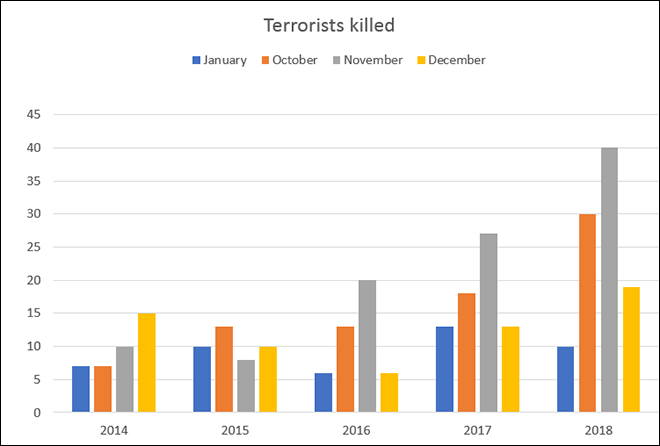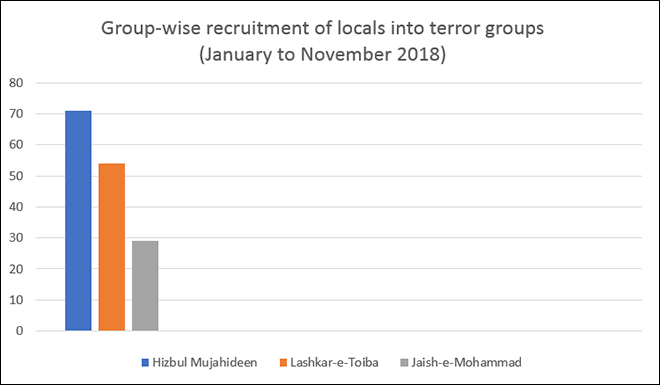-
CENTRES
Progammes & Centres
Location
The operational success of the security forces is commendable, but their real test would be against the hard-core and well-trained JeM and LeT terrorists of Pakistani origin, who easily get mixed with the locals and unlike the local HM boys, whose identity is not revealed on social media.

Image Source: PTI
The sub-zero temperatures in the Kashmir Valley have heated up this winter with the security forces keeping up the frequency of counterinsurgency operations. In a marked change in strategy, the security forces have chosen not to scale down counter-terror operations during the winter months, when terrorists are forced to move out from their snow-covered hideouts and expose themselves, making it easier for the security forces to neutralise them.
In the past two-odd months alone, security forces have killed 62 terrorists. Forty were eliminated in November alone, 19 in December and three in January so far. The figures for these months are the highest compared to the figures of the corresponding period in the last three years. However, the highlight was the December offensive when the security forces killed majority members of Gazwat-ul-Hind headed by Zakir Musa.
 Source: South Asia Terrorism Portal
Source: South Asia Terrorism Portal
In the winter months, looking for safe havens, terrorists generally shift base from their hideouts in the jungles and mountains to the populated areas in towns and villages in the Valley. On the other hand, if they are compelled to stay in the snow-clad mountains, they are wary of movements as their footprints tend to give away vital details about their whereabouts and numbers to the area domination patrol party of the army.
While new recruits from the Valley — which also include minor boys who have been lured to militancy — are being eliminated in the rising spate of encounters, infiltration along the Line of Control (LoC), too, has been by and large halted due to heavy layers of snow and heightened 24×7 vigil.
For terrorists, hiding in Kashmir is not difficult. Local area commanders generally remain within their area as they are well aware of the landscape. They enjoy immense popularity and loyalty of the locals. While the twisted jungle routes and mountain ranges with thick forest cover provide natural cover to the terrorists, the narrow lanes and close proximity of houses, too, provide comfortable hideouts as well as escape routes. Not to mention the local mobs who help them escape from the scene in case of encounters with the security forces.
Throughout 2017 and 2018, Rashtriya Rifles units, regular army, Territorial Army battalions, CRPF and J&K police have maintained the tempo of their operations and there are no signs of slowing up the pace even during the current winter months. At the same time, the return of Cordon and Search Operations (CASO) in July 2018, after a gap of nearly 15 years, in the volatile areas of Pulwama, Kulgam, Tral, Budgam and Shopian, have paid off. CASO and Search and Destroy Operations (SADO) are infamous for their harshness, but they are a military necessity, to force the terrorists to come out of their shelters. While new recruits from the Valley — which also include minor boys who have been lured to militancy — are being eliminated in the rising spate of encounters, infiltration along the Line of Control (LoC), too, has been by and large halted due to heavy layers of snow and heightened 24x7 vigil.
However, unlike earlier, the Pakistani army, by using snipers to target Indian patrol parties, has once again managed to open up infiltration routes along the international border (IB) in the Samba sector of Jammu. According to reports, an estimated 40 terrorists have been pushed into Jammu, who are believed to have been directed to the Kashmir Valley by the Over-Ground Workers (OGWs). The OGWs are networks of select local youth who help militants with specific information to choose their targets. This is a tactical shift in Pakistan’s strategy to make Jammu the next hub of its cross-border activities. With fresh LeT and Jaish terrorists making their way to the Valley via Jammu is likely to escalate the threat levels in the coming months as these groups are known for attacking military installations and also carry out suicide missions. To add to the worries of the security forces, the recent years have witnessed a spurt in the local youth joining the LeT and JeM, leading to increased coordination with the Hizbul Mujahideen, the local militant group. As a result, the three groups have blurred the operational boundaries among themselves and have also expanded their area of operations.
Throughout 2017 and 2018, Rashtriya Rifles units, regular army, Territorial Army battalions, CRPF and J&K police have maintained the tempo of their operations and there are no signs of slowing up the pace even during the current winter months.
Going by the recent recruitment numbers, though the HM tops the chart, JeM and LeT are not far behind. These groups have successfully influenced, radicalised and weaponised local Kashmiris to carryout fidayeen attacks and spread religious extremism. These JeM and LeT terrorists of Pakistan origin are thoroughly trained and indoctrinated in comparison to their home-grown HM counterparts, who have little training facilities in the jungles of Kashmir to be mission-ready.
 Source: Security agencies
Source: Security agencies
While a majority of encounters post the onset of winter have taken place between the security forces and HM terrorists, the relative silence of JeM, LeT and the separatists is conspicuous. Suicide missions and meticulous terror strikes are difficult to be carried out in the snow-clad Valley, so are the calls for hartals and bandhs. The operational success of the security forces is commendable, but their real test would be against the hard-core and well-trained JeM and LeT terrorists of Pakistani origin, who easily get mixed with the locals and unlike the local HM boys, whose identity is not revealed on social media.
The unprecedentedly high rate of counterinsurgency operations witnessed over the past few years with no respite even in the winter months has clearly highlighted New Delhi’s intent. The last 30-odd months have been catastrophic for terrorists. Thanks to the regular and meticulously conducted counterinsurgency operations, in 2018 alone, nine top terrorist commanders were eliminated. If the current thrust of operations continues, the security forces look determined to hunt down the remaining number of around 240-250 terrorists. The security forces will continue to win the battles on the streets, but at the cost of increased alienation of the Kashmiri youth. This may not a desirable outcome for either Kashmir or India.
The views expressed above belong to the author(s). ORF research and analyses now available on Telegram! Click here to access our curated content — blogs, longforms and interviews.

Parjanya was a Research Fellow with ORF Mumbai chapter. His research focuses on terrorism and the security situation in the state of Jammu and Kashmir. ...
Read More +